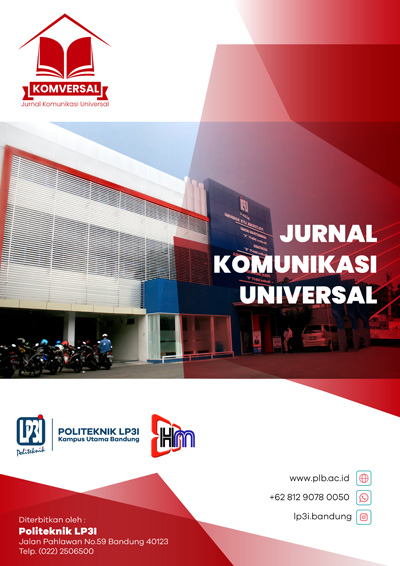Strategi Branding Nescafe Melalui Coffee Booth Di Bandung Pendekatan Experiential Marketing
DOI:
https://doi.org/10.38204/komversal.v7i2.2597Keywords:
Branding, Experiential Marketing, Nescafé, Booth Activation, BandungAbstract
The intense competition within the instant coffee market in Indonesia necessitates the implementation of marketing strategies that are not only informative but also capable of building holistic and memorable consumer experiences. This research focuses on a case study of Nescafé, which utilizes an experiential marketing approach through the activation of its coffee booths in Bandung as a strategic means to enhance brand engagement and consumer loyalty. The primary objective of this study is to analyze Nescafé's branding strategy by referencing Schmitt's five dimensions of experiential marketing (1999): Sense, Feel, Think, Act, and Relate. The research employs a descriptive qualitative method, with data collection techniques comprising observation and literature review. The findings indicate that Nescafé's coffee booths effectively integrate all five dimensions in consumer interactions, creating a comprehensive experience. In conclusion, Nescafé's implementation of experiential marketing has proven capable of fostering positive brand experiences, strengthening brand image, and increasing engagement among young consumers in Bandung.
Downloads
References
Book
Aaker, D. A. (1991). Managing brand equity: Capitalizing on the value of a brand name. The Free Press.
Creswell, J. W., & Creswell, J. D. (2018). Research design: Qualitative, quantitative, and mixed methods approaches (5th ed.). SAGE Publications.
Keller, K. L. (2013). Strategic brand management (4th ed.). Pearson Education.
Kotler, P., & Keller, K. L. (2016). Marketing management (15th ed.). Pearson Education.
Krishna, A. (2012). Sensory marketing: Research on the senses. Routledge.
Lindstrom, M. (2005). Brand sense: Build powerful brands through touch, taste, smell, sight, and sound. Free Press.
Oliver, R. L. (1997). Satisfaction: A behavioral perspective on the consumer. McGraw-Hill.
Patton, M. Q. (2015). Qualitative research & evaluation methods (4th ed.). SAGE Publications.
Pine, B. J., II, & Gilmore, J. H. (1999). The experience economy: Work is theater & every business a stage. Harvard Business School Press.
Schmitt, B. (1999). Experiential marketing: How to get customers to sense, feel, think, act, and relate to your company and brands. The Free Press.
Schmitt, B. H. (2011). Experiential marketing: How to get customers to Sense, Feel, Think, Act, Relate (Rev. ed.). Free Press.
Smith, S. (2016). Experience marketing: Secrets, stories, and success. Smith & Hiestand.
Szmigin, I., & Piacentini, M. (2015). Consumer behaviour (2nd ed.). Oxford University Press.
Jurnal online
Brakus, J. J., Schmitt, B. H., & Zarantonello, L. (2009). Brand experience: What is it? How is it measured? Does it affect loyalty? Journal of Marketing, 73(3), 52–68. https://doi.org/10.1509/jmkg.73.3.52
Carroll, B. A., & Ahuvia, A. C. (2006). Some antecedents and outcomes of brand love. Marketing Letters, 17(2), 79–89. https://doi.org/10.1007/s11002-006-4219-2
Fournier, S. (1998). Consumers and their brands: Developing brand relationships. Journal of Consumer Research, 24(4), 343–373. https://doi.org/10.1086/209515
Gentile, C., Spiller, N., & Noci, G. (2007). How to sustain the customer experience: An overview of experience components that co-create value with the customer. European Management Journal, 25(5), 395–410. https://doi.org/10.1016/j.emj.2007.08.005
Havlena, W. J., & Holbrook, M. B. (1986). The varieties of consumption experience: Designing an ethnographic study of retailing experiences. Journal of Consumer Research, 13(3), 395-408. https://doi.org/10.1086/209078
Hsieh, H. F., & Shannon, S. E. (2005). Three approaches to qualitative content analysis. Qualitative Health Research, 15(9), 1277–1288. https://doi.org/10.1177/1049732305276559
Ibrahim, A., & Aljarah, A. (2020). The effect of experiential marketing on customer loyalty: The mediating role of brand love and word-of-mouth. Journal of Relationship Marketing, 19(3), 195–216. https://doi.org/10.1080/15332667.2020.1772186
Lemon, K. N., & Verhoef, P. C. (2016). Understanding customer experience throughout the customer journey. Journal of Marketing, 80(6), 69–96. https://doi.org/10.1509/jm.15.0420
Mangold, W. G., & Faulds, D. J. (2009). Social media: The new hybrid element of the promotion mix. Business Horizons, 52(4), 357–365. https://doi.org/10.1016/j.bushor.2009.03.002
McAlexander, J. H., Schouten, D. J., & Koenig, S. F. (2002). Building brand community. Journal of Marketing, 66(1), 38–54. https://doi.org/10.1509/jmkg.66.1.38.18485
North, A. C., Hargreaves, D. J., & McKendrick, J. (2000). The effects of music on atmosphere and purchase intentions in a retail environment. Journal of Applied Psychology, 85(2), 293–301. https://doi.org/10.1037/0021-9010.85.2.293
Fournier , Susan. (1998). Consumers and their brands: Developing brand relationships. Journal of Consumer Research, 24(4), 343–373. https://doi.org/10.1086/209515
Weinberg, B. D., & Pehlivan, E. (2011). Social media, marketing communications, and consumer behavior: A review and conceptual framework. Journal of Research in Interactive Marketing, 5(2/3), 162–179. https://doi.org/10.1108/17505931111151347















